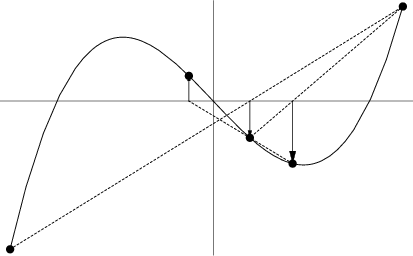|
|
|

A Root-finding algorithm which assumes a function to be approximately linear in the region of interest. Each
improvement is taken as the point where the approximating line crosses the axis. The secant method retains only the
most recent estimate, so the root does not necessarily remain bracketed. When the Algorithm does converge, its
order of convergence is
| (1) |
| (2) |
| (3) |
| (4) |
| (5) |
See also False Position Method
References
Press, W. H.; Flannery, B. P.; Teukolsky, S. A.; and Vetterling, W. T. ``Secant Method, False Position Method,
and Ridders' Method.'' §9.2 in
Numerical Recipes in FORTRAN: The Art of Scientific Computing, 2nd ed. Cambridge, England:
Cambridge University Press, pp. 347-352, 1992.